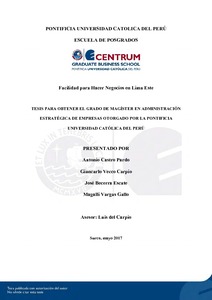| dc.contributor.advisor | Carpio Castro, Luis Alfonso del | |
| dc.contributor.author | Castro Pardo, Antonio | es_ES |
| dc.contributor.author | Vecco Carpio, Giancarlo | es_ES |
| dc.contributor.author | Becerra Escate, José | es_ES |
| dc.contributor.author | Vargas Gallo, Magalli | es_ES |
| dc.date.accessioned | 2017-09-29T00:10:54Z | |
| dc.date.available | 2017-09-29T00:10:54Z | |
| dc.date.created | 2017 | |
| dc.date.issued | 2017-09-29 | |
| dc.identifier.uri | http://hdl.handle.net/20.500.12404/9408 | |
| dc.description.abstract | La presente investigación tiene por finalidad encontrar respuesta a la pregunta ¿Qué
tan fácil es realizar negocios en Lima Este, para el año 2016? La facilidad para realizar
negocios se determina calculando cuánto cuesta y cuánto tiempo toma el constituir
formalmente una empresa, registrar una propiedad, obtener permisos de construcción, obtener
electricidad, y finalmente resolver judicialmente un contrato comercial con un proveedor,
para la ciudad de Lima Este el año 2016. Lima Este está geográficamente comprendida
dentro de la ciudad de Lima, y se caracteriza por ser una región con alta concentración de
industrias y comercios, en donde muchos emprendedores optan por realizar sus negocios de
manera informal, ante el tiempo y costo que les conlleva realizarlos por la vía formal.
La metodología utilizada para el estudio de investigación se basa en el informe Doing
Business del Banco Mundial, que busca determinar la facilidad para realizar negocios en una
determinada región, analizando diez pilares base, y uniformizando la investigación en base a
casos de estudio estándar por cada pilar. La investigación se delimita a cinco de los diez
pilares cubiertos por el informe Doing Business, los cuales son: (a) apertura de una empresa,
(b) registro de propiedad, (c) permisos de construcción, (d) obtención de electricidad, y (e)
cumplimiento de contratos. Para hacer comparativos los resultados de la ciudad objetivo
Lima Este, con otras ciudades, se utiliza el método de distancia de frontera.
La investigación es de naturaleza cuantitativa y descriptiva. Se orienta a analizar las
brechas entre la información real, obtenida de entrevistas a expertos, y la información de
gabinete, o normativa vigente de cada pilar de estudio. Concluye presentando el tiempo y
costo incurrido, así como recomendaciones para reducir las brechas y mejorar el proceso de
realización de negocios en la región. La importancia del presente estudio es la posibilidad de
extrapolar los resultados a regiones más grandes, incluido el Perú, y servir de referencia a la
Administración Pública Peruana que busca mejorar el clima de negocios | es_ES |
| dc.description.abstract | This research aims to find an answer to the question: How easy is it to do business in
Lima East, for the year 2016? The ease of doing business is determined by calculating how
much it costs and how long it takes to formally establish a business, register a property,
obtain construction permits, obtain electricity, and finally enforce a commercial contract with
a supplier, for the city of Lima East the year 2016. Lima East is geographically comprised
within the city of Lima, and is characterized as a region with a high concentration of
industries and commerce, where many entrepreneurs choose to conduct their business in an
informal manner, given the time and cost involved them by the formal route.
The methodology used for the research study is based on the Doing Business report of
the World Bank, which seeks to determine the ease of doing business in a given region,
analyzing ten basic pillars, and standardizing research based on standard case studies for each
pillar. The investigation is limited to five of the ten pillars covered by the Doing Business
report, which are: (a) opening a business, (b) property registration, (c) construction permits,
(d) getting electricity, and (e) enforcing contracts. To compare the results of the target city of
Lima East, with other cities, the border distance method is used.
The research is quantitative, qualitative and descriptive. It is aimed at analyzing the
gaps between actual information, obtained from interviews with experts, and the cabinet
information, or current regulation of each pillar of study. It concludes by presenting the time
and cost incurred, as well as recommendations to reduce gaps and improve the process of
conducting business in the region. The importance of this study is the possibility of
extrapolating results to larger regions, including Peru, and serve as a reference to the
Peruvian Public Administration that seeks to improve the business climate | es_ES |
| dc.language.iso | spa | es_ES |
| dc.publisher | Pontificia Universidad Católica del Perú | es_ES |
| dc.rights | info:eu-repo/semantics/openAccess | es_ES |
| dc.rights.uri | http://creativecommons.org/licenses/by-nc-nd/2.5/pe/ | * |
| dc.subject | Nuevas empresas | es_ES |
| dc.subject | Emprendimiento (Administración) | es_ES |
| dc.subject | Investigación cuantitativa | es_ES |
| dc.title | Facilidad para hacer negocios en Lima Este | es_ES |
| dc.type | info:eu-repo/semantics/masterThesis | es_ES |
| thesis.degree.name | Maestro en Administración Estratégica de Empresas | es_ES |
| thesis.degree.level | Maestría | es_ES |
| thesis.degree.grantor | Pontificia Universidad Católica del Perú. CENTRUM | es_ES |
| thesis.degree.discipline | Administración Estratégica de Empresas | es_ES |
| renati.discipline | 413307 | es_ES |
| renati.level | https://purl.org/pe-repo/renati/level#maestro | es_ES |
| renati.type | https://purl.org/pe-repo/renati/type#tesis | es_ES |
| dc.publisher.country | PE | es_ES |
| dc.subject.ocde | https://purl.org/pe-repo/ocde/ford#5.02.04 | es_ES |






